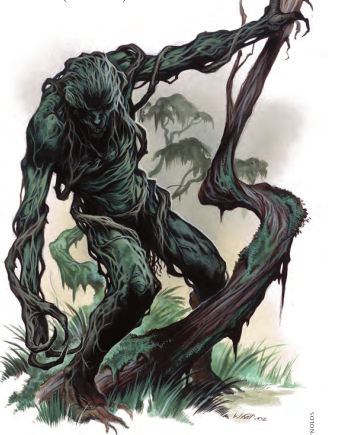Let's Read the 4e Monster Manual/Vault: Vine Horror

This article is part of a series! Click here to see the other entries.
One of the many plant monsters of D&D, I’m not sure where vine horrors first appeared. They look like a 3e thing but could have been in a supplement for an earlier edition. Here, they’re only on the Monster Manual.
The Lore
Like shambling mounds, vine horrors are created “naturally” through an unlikely sequence of events. If an evil person dies in an area touched by the Shadowfell, their blood might end up soaking the earth and infusing the local plant life, which animates as a new vine horror. They’re undead-adjacent, but not undead themselves.
Vine horrors are humanoid plant masses who bear a vague resemblance to the dead person whose blood gave them life. Some times they even display some of that person’s abilities: for example, a vine horror who rises from a wizard might be able to cast a few spells.
Personality-wise, they display human level intelligence and tend to be cruel serial killers. The books say they like to ambush and kill passing sapients, but doesn’t make any mention of them needing to do it. It would make sense if they needed to keep draining blood to live, but it also fits to say that a vine horror feeds on soil and sunlight just like any other plant and just kills people because it likes to.
The Numbers
Vine horrors are Medium Natural Humanoids with the Plant keyword. They have blindsight, a land speed of 6 with both swamp and forest walk, and a swim speed of 6.
A vine horror’s humanoid shape isn’t a constant - they’re Malleable enough to squeeze into any 1-inch or wider opening without slowing down at all. They have claws, and can also partially uncoil to strike their victims with vines whose exact effects vary by stat block.
Vine Horror
The basic model is a Level 5 Controller with 67 HP. Aside from its basic claws, it can use its Vicious Vines once per encounter. This Close Burst 5 vs. Reflex restrains and does 10 ongoing damage on a hit (save ends both).
Its Stealth training, varied movement modes and malleability ensure the horror will be a in a good position to use Vicious Vines as a fight-opener. After that, it and its buddies can go to town on the weakened party.
Vine Horror Spellfiend
An example of a wizard-derived horror who can cast some spells. It’s Level 7 Artillery and has 65 HP. It can only use claws in melee, but has a lot of ranged options.
Shock Orb (ranged 10 vs. Reflex) does lightning damage. Lashing Vine of Dread (ranged 5 vs. Reflex; fear) does physical damage and pushes the target 5 squares on a hit. Caustic Cloud (area burst 1 within 10 vs. Fortitude) does immediate and ongoing acid damage, and also blinds (save ends both).
Looks like spellfiends pair wonderfully with shambling mounds, since their at-will lightning powers can heal the mounds. They can also use their fear vines to herd the party into position for Caustic Cloud, a process that’s a lot quicker if you have a pair of spellfiends in the encounter group instead of just one.
Sample Encounters and Final Impressions
The book does mention the possible shambling mound partnerships, but the example encounter it gives is a little less synergistic: Level 9, 2 spellfiends, 1 bog hag, and 2 trolls. A clever party might be able to turn those caustic clouds to their advantage.
Story-wise vine horrors don’t do much for me. They’re just one creepy plant monster among many others. Mechanically, I’d like to see how an encounter featuring spellfiends and shambling mounds would go.